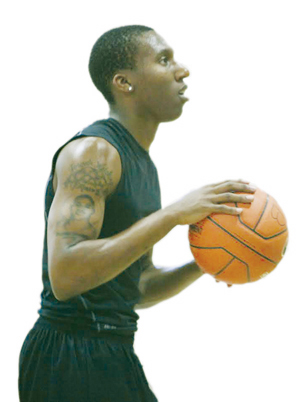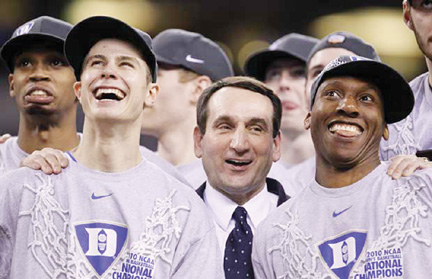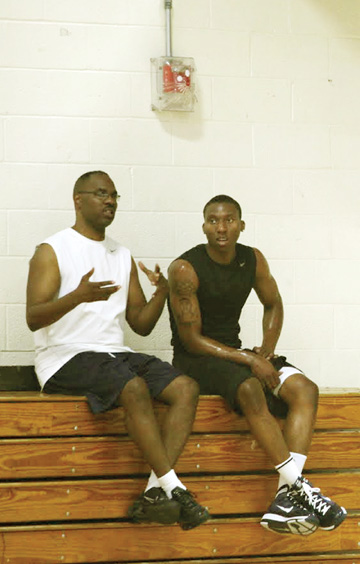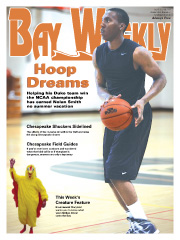 Hoop Dreams
Hoop Dreams
Helping his Duke team win the NCAA basketball championship has earned Nolan Smith, of Upper Marlboro, no summer vacation
a Bay Weekly exclusive by Ron Stein
Only 3.6 seconds remained in the last college basketball game of the season, on April 5, when Butler’s Gordon Hayward grabbed a rebound and sped upcourt.
The six-foot-eight Hayward, soon to be a wealthy pro, launched a prayer from 50 feet. Its trajectory held rapt the attention of some 49 million people watching on television — not to mention the thousands in Lucas Oil Stadium in Indianapolis, Indiana.
Would the ball go in to provide a real-life Hoosiers ending for tiny Butler against mighty Duke?
“Please, no,” whispered Nolan Smith, an Upper Marlboro native and a mainstay for the Blue Devils.
Hayward’s shot hit the backboard and caromed off the front of the rim. With that bounce, Duke’s Blue Devils edged out the Butler Bulldogs 61-59 to win the National Collegiate Athletic Association championship in one of the most exciting finishes ever to a college basketball season.
“When it hit the backboard, I knew it wasn’t going in,” Smith told Bay Weekly. “It was a sigh of relief, and I went to go celebrate with my teammates.”
And then? What does a guy like Nolan Smith do the summer after helping his team win the college basketball championship?
 Nolan Smith, right, celebrates with coach Mike Krzyzewski and his Blue Devil teammates after winning the 2010 NCAA championship. Nolan Smith, right, celebrates with coach Mike Krzyzewski and his Blue Devil teammates after winning the 2010 NCAA championship.
|
Getting There
First, you’ve got to understand what it took to stand in Smith’s shoes at Lucas Oil Stadium.
He played all 40 minutes of the riveting game and scored 13 points, with four assists and three rebounds. He was a force on the court as his team pushed to victory.
All young basketball players dream of winning the NCAA championship. College play is the last chance for the big time; only a little over one percent — the best of the best — of college basketball players are drafted by the NBA each year. So the student-athletes, even those on the weaker teams, compete at their highest level. The competition makes for exciting games throughout March Madness, the three-week tournament that draws in millions of devoted fans.
Playing basketball at Duke automatically puts Smith and his teammates at the top of the competition. Duke is led by legendary coach Mike Krzyzewski, who has coached the Blue Devils for 30 seasons. His teams have won four NCAA Championships and made it to 15 Final Fours. Only UCLA and University of North Carolina — at 18 each — have had more semifinal appearances.
Duke Blue Devils basketball is the equivalent of the New York Yankees in baseball or the Dallas Cowboys in football: You either love them or hate them. Duke fans, known as the Cameron Crazies, pack Cameron Indoor Stadium for each home game.
Smith, who enters his senior year at Duke as co-captain with sharpshooter Kyle Singler, worked his whole life to play with a team like the Blue Devils.
All along, he had a clear vision of where he was going.
Smith is the son of the late Derek Smith, who won his own NCAA basketball championship with Louisville in 1980. Derek Smith died in 1996.
“I had a chance to win a championship like my father, in the same city, and I thought about that before the game,” Smith said. “I just wanted to go out there and take care of business.”
Following the championship victory, the Blue Devils were on top of the world. Their victory rounds included visiting the White House where they met President Barack Obama.
After weeks of celebrating, Smith went to work.
“As soon as I got home, I was right back in the gym to prepare for next season,” he said. “I am thinking about next year already and really focusing on the chance to possibly do it again.”
The Summer After
Smith enters Lake Arbor Community Center in Bowie at the crack of dawn. There is not a cloud in the sky, and it’s warm for so early in the day. He was up late — not partying but watching Game 7 of the NBA finals in which the Los Angeles Lakers defeated the Boston Celtics. Still, he made it to the gym bright and early.
As Smith walks through the door, he’s accompanied by a tall kid along to watch the workout. This six-foot-five fellow is Jaelin Grant, son of former NBA player Harvey Grant and nephew of another NBA player, Horace Grant. Jaelin’s going to be starting his freshman year at DeMatha Catholic High School in Hyattsville, a school that breeds professional basketball players. Smith likes to bring young players from the neighborhood to watch his workouts to get a feel for the intensity and hard work that go into rising as a basketball star.
 photo by Lauren Rock photo by Lauren Rock
Smith works with Gary Lampkins, basketball coach at Dunbar High School in D.C. Training with Lampkins before last season improved his game, Smith said.
|
Smith works with Gary Lampkins, basketball coach at Dunbar High School in D.C., to prepare for his final year at Duke. Training with Lampkins before last year improved his game, Smith said.
“He has trained a couple of professionals in this area,” Smith said of his choice of trainer. “He is a mental guy, but he knows what he’s doing on the basketball court.”
Smith is wearing a blue, tucked-in sleeveless shirt, white Duke shorts and blue and white shoes. His outfit matches, even though this is only a workout with two people watching. A tattoo takes up most of his right arm. It’s a tribute to his father, his face with the words forever watching.
As soon as Lampkins arrives, Smith grabs a ball and starts shooting. He takes a variety of jump shots from all over the court. You hear the swoosh of the ball going through the net as he makes most of them. The workout hasn’t even begun, but the 21-year-old seems happy just to have the ball in his hands.
When the workout starts, Lampkins plays defense on Smith as he shoots. The two crack jokes, laugh and smile.
Lampkins shouts encouragement as Smith takes shot after shot. Moving into the first drill, there is less joking. Smith wears a determined look; he’s a champion, yet he’s determined to get better.
Next, Nolan goes to the foul line to shoot free throws. Players at all levels practice free throws because they’re a way to get easy points. Still, they’re easier to make in an empty gym than in front of 20,000 people. Smith is working to improve his form and routine so he can duplicate them under high pressure.
For the next hour, Lampkins makes Smith work harder in a series of fast, challenging drills on all aspects of his game.
They shoot three-pointers, long shots from at least 20-feet-nine inches, that are a big part of Smith’s game. They work on a shot called the teardrop or floater, a shot off the dribble where the airborne player softly lets go of the ball a few feet in front of the basket — and it floats in. Smith missed the shot for most of the drill, but he didn’t stop pushing himself. He’s not only improving his skills, he’s building his endurance for 40 minutes of non-stop action.
Toward the end of the workout, Smith breaks a sweat. The tattoo of his father on his right arm glistens. The drill he’s working would leave most people on the ground, gasping for air and begging to end. It’s a mix of quick shooting and pushing the ball up the court so fast that if you blinked, you’d miss it. Smith spits out words of encouragement to himself during the drill: never tired, never scared. These words are a mantra, motivating him to push through the pain, no matter how bad it becomes. His ability to stay focused is uncanny.
Smith ends his workout in the weight room. There he rides the stationary bike set on high resistance, lifts weights and does an exercise with tiny jumps to work on his calves. This day is a leg day, so most of what he does focuses on leg strength. He alternates between upper-body and lower-body days.
At the end of 90 minutes, Smith is done. Now he must rush to catch a flight to Louisville for the Derek Smith Shootout, a basketball tournament for young players in honor of his father. Before this busy day of traveling, he wanted to get his workout.
Leaving the Lake Arbor Community Center gym, he notices two kids, no more than eight or nine, shooting baskets. He detours to give them high fives before walking out the door.
Hometown Star
They’re the type of kids the superstar grew up with in his hometown of Upper Marlboro. He’s lived in the same house for nine years and says that everyone in the area is really close, especially when it comes to basketball.
“We all stay connected and stayed in touch when we went to separate schools,” Smith said of the players he grew up with.
Growing up where he did helped his game, because Maryland breeds basketball talent.
“The thing with this area is that we have so many great basketball players who have gone to different colleges around the country,” Smith said. “There was always someone to compete with and get better.”
For the six years from second to eighth grade, Smith went to Key School at the edge of Annapolis.
“Key School gave me the great education I needed to go to a school like Duke,” Smith said.
From Key, he moved to Riverdale Baptist School in Upper Marlboro for a year, then away to Oak Hill Academy to continue on his basketball journey. At Oak Hill’s 400 acres in the Blue Ridge Mountains, he played with some of the best high school basketball players in the country and learned from the finest coaches at that level.
Oak Hill’s coach Steve Smith is one of the highest regarded high school coaches in the nation. He has been named coach of the year three times. His teams have won seven National High School Championships. Seventeen of his previous players have been drafted to the NBA, and he has coached 23 McDonald’s All-Americans.
“All of the coaches at Oak Hill have been there for me,” Smith said. “Those guys have been great mentors for me and helped progress my game.”
 Soft-spoken yet funny and energetic, Smith says, “I could definitely do some acting in movies someday.” Soft-spoken yet funny and energetic, Smith says, “I could definitely do some acting in movies someday.”
|
Besides Oak Hill’s coaches and players, another key figure in Smith’s life and basketball career is stepfather Curtis Malone. Smith says that Malone, who has always been there for him and suggested Duke as his college, ranks close to his mother, Monica Malone, and sister, Sydney, in influencing his life.
Smith was just eight years old when his father — then a Washington Bullets assistant coach — died after suffering a heart attack on a cruise ship. The young Nolan stood over him, unaware that was the last time he’d ever see his father.
“My mom and my sister have really had my back through whatever — basketball, picking a high school, picking a college, picking an AAU team,” Smith said. “They haven’t steered me wrong yet.”
Fierce competitor though he is, Smith is playful. “I am a big kid,” he said, “I love to be active.”
You might run into him playing laser tag or riding go-carts.
Or in his old capital city haunts from his days at Key School: Annapolis Harbour Center or downtown at City Dock or the mall.
“Annapolis is a really nice area,” Smith said. “I will go out there and get some food just to get away from Prince George’s County.”
The Future
Smith intends to make a push for the NBA after Duke, following in the footsteps of his father and other father-son duos. Like Smith, Gerald Henderson Jr. played at Duke before becoming 12th overall pick in the 2009 NBA draft. His father, Gerald Henderson Sr., played at Virginia Commonwealth University before a successful 13-year career in the NBA.
“As of right now, I feel like I am on a great track to do that,” said Smith, “I will continue to work hard in the off season and get my body ready, and everything else will fall into place.”
His faith has roots in reality.
“Nobody thought we could do it this year, but we believed in ourselves and worked hard,” Smith said. “If you do the same type of thing, then you can do anything you want.”
Nowadays, that’s championship-level basketball. Some day down the road, it might be stand-up comedy or acting.
“With me and my natural ability,” he said, “I could definitely do some acting in movies someday.”
![]()


 Hoop Dreams
Hoop Dreams Nolan Smith, right, celebrates with coach Mike Krzyzewski and his Blue Devil teammates after winning the 2010 NCAA championship.
Nolan Smith, right, celebrates with coach Mike Krzyzewski and his Blue Devil teammates after winning the 2010 NCAA championship. photo by Lauren Rock
photo by Lauren Rock Soft-spoken yet funny and energetic, Smith says, “I could definitely do some acting in movies someday.”
Soft-spoken yet funny and energetic, Smith says, “I could definitely do some acting in movies someday.” Can’t Get Enough?
Can’t Get Enough?